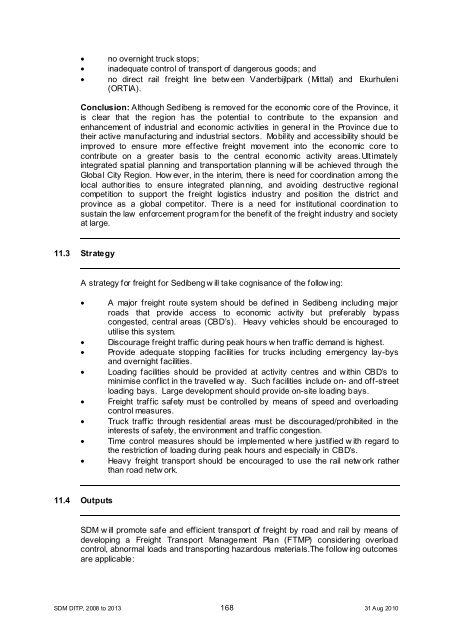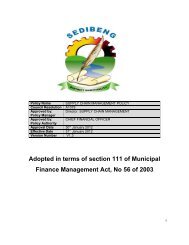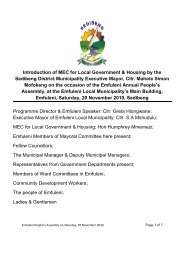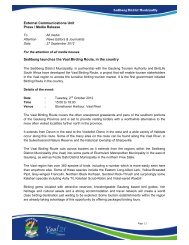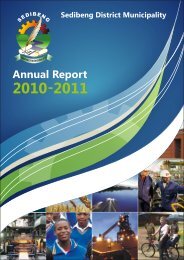Chapter 11 - Sedibeng District Municipality
Chapter 11 - Sedibeng District Municipality
Chapter 11 - Sedibeng District Municipality
You also want an ePaper? Increase the reach of your titles
YUMPU automatically turns print PDFs into web optimized ePapers that Google loves.
• no overnight truck stops;<br />
• inadequate control of transport of dangerous goods; and<br />
• no direct rail freight line betw een Vanderbijlpark (Mittal) and Ekurhuleni<br />
(ORTIA).<br />
Conclusion: Although <strong>Sedibeng</strong> is removed for the economic core of the Province, it<br />
is clear that the region has the potential to contribute to the expansion and<br />
enhancement of industrial and economic activities in general in the Province due to<br />
their active manufacturing and industrial sectors. Mobility and accessibility should be<br />
improved to ensure more effective freight movement into the economic core to<br />
contribute on a greater basis to the central economic activity areas.Ultimately<br />
integrated spatial planning and transportation planning w ill be achieved through the<br />
Global City Region. How ever, in the interim, there is need for coordination among the<br />
local authorities to ensure integrated planning, and avoiding destructive regional<br />
competition to support the freight logistics industry and position the district and<br />
province as a global competitor. There is a need for institutional coordination to<br />
sustain the law enforcement program for the benefit of the freight industry and society<br />
at large.<br />
<strong>11</strong>.3 Strategy<br />
A strategy for freight for <strong>Sedibeng</strong> w ill take cognisance of the follow ing:<br />
• A major freight route system should be defined in <strong>Sedibeng</strong> including major<br />
roads that provide access to economic activity but preferably bypass<br />
congested, central areas (CBD’s). Heavy vehicles should be encouraged to<br />
utilise this system.<br />
• Discourage freight traffic during peak hours w hen traffic demand is highest.<br />
• Provide adequate stopping facilities for trucks including emergency lay-bys<br />
and overnight facilities.<br />
• Loading facilities should be provided at activity centres and within CBD’s to<br />
minimise conflict in the travelled w ay. Such facilities include on- and off-street<br />
loading bays. Large development should provide on-site loading bays.<br />
• Freight traffic safety must be controlled by means of speed and overloading<br />
control measures.<br />
• Truck traffic through residential areas must be discouraged/prohibited in the<br />
interests of safety, the environment and traffic congestion.<br />
• Time control measures should be implemented w here justified w ith regard to<br />
the restriction of loading during peak hours and especially in CBD’s.<br />
• Heavy freight transport should be encouraged to use the rail netw ork rather<br />
than road netw ork.<br />
<strong>11</strong>.4 Outputs<br />
SDM w ill promote safe and efficient transport of freight by road and rail by means of<br />
developing a Freight Transport Management Plan (FTMP) considering overload<br />
control, abnormal loads and transporting hazardous materials.The follow ing outcomes<br />
are applicable:<br />
SDM DITP, 2008 to 2013 168 31 Aug 2010


